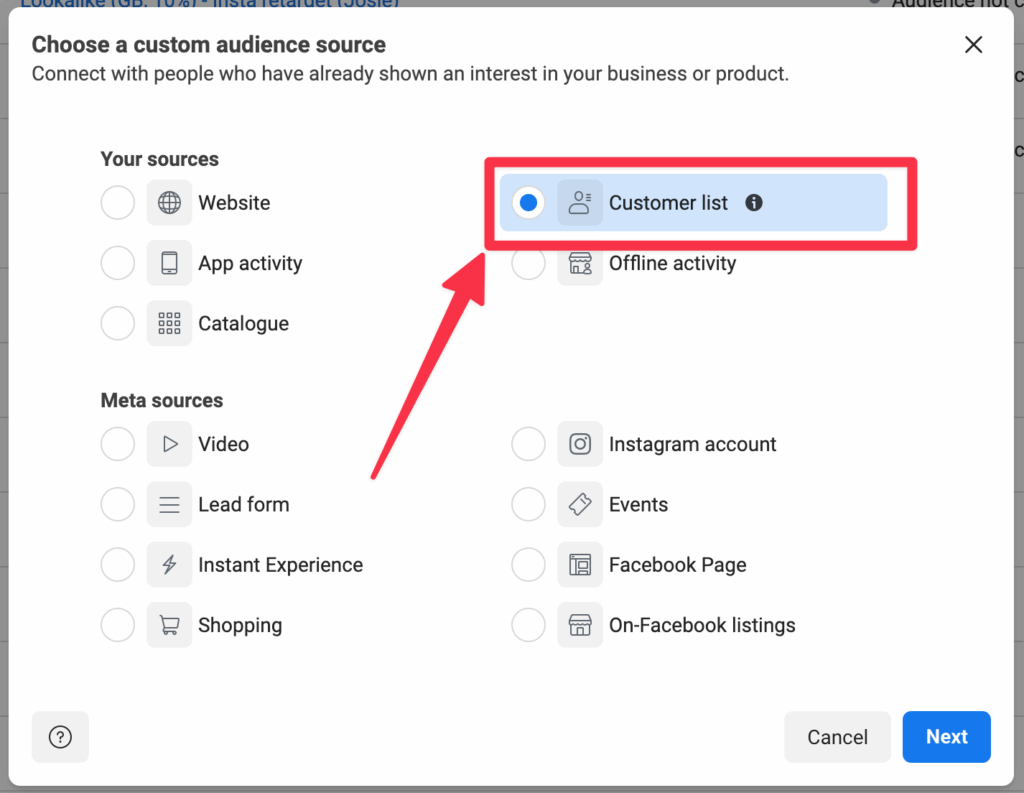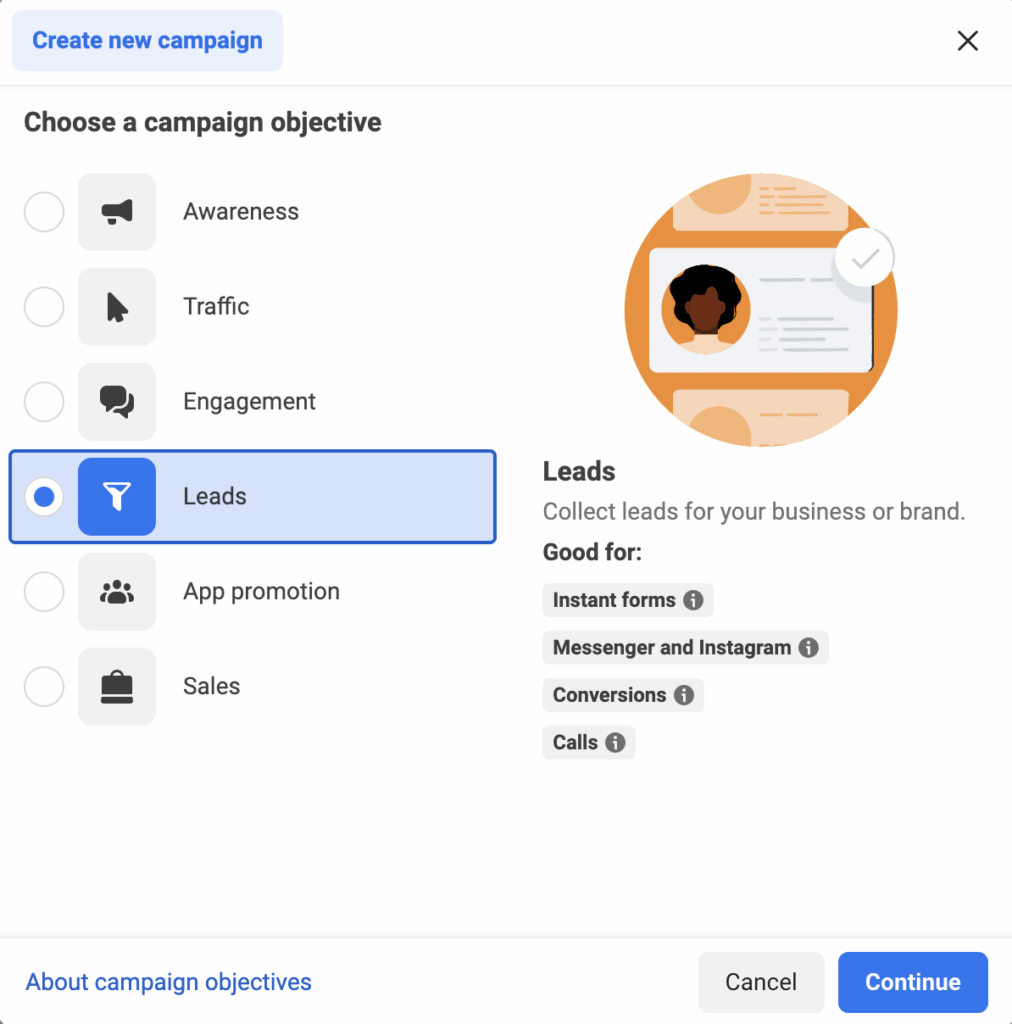Create a ‘full-funnel’ experience for your audience
We’ll guide you through the only Meta ads strategy for property developers. As per most industries who choose paid social media to advertise their business & products, the property development industry is no different. We hear time and time again, “but this won’t work on Facebook” or “Facebook ads don’t work”. The truth is they do, otherwise all the businesses advertising on Meta would just be donating their marketing budgets.
The two key things to remember with Meta (Facebook) ads, is objective and creative. From the outset, ensure your objective matches the end goal of your overall marketing strategy. For example, if your goal is awareness, don’t expect the campaign to generate leads. Meta will focus on the one key goal and users who are likely to meet it.
Creative is now more important than your targeting. Think about it, it’s what the user sees first when they are scrolling, they don’t see all your meticulously researched targeting. Chances are if they are seeing it, it’s because Meta has done the leg work with the targeting and found the right user. Ensure your creative will create “thumb stopping moments”.
So how can this this be applied to the property developers industry?
At Giraffe we are all about Human First marketing. This has been developed by our CEO, Phil and he’s written a book about it if you’d like to learn more – “Human First Marketing – The Art of Being Seen, Heard and Remembered”
Part of this includes the “marketing-flywheel” – a new way of looking at the marketing funnel.

Attract – the property developers way
Traditionally this would be your awareness stage of the funnel. From a Human-First perspective we want make it seem more personal and dig into what does attract someone to your property developers business.
When your creating your “Attract” part of the campaign, choose the Awareness objective if you want people to learn about your business. Consider the Reach objective if you just to want to reach the most amount of property developers possible.
Other campaign types you consider during this phase are Traffic. This may seem more like a middle of the “flywheel” campaign, but using traffic campaigns to start generating traffic to your website can be pay off later. You can then re-target the users who visited your website. From this you can retarget users who perhaps didn’t take any action initially, or perhaps if you’ve got a specific offer you want them to see. But let’s not get ahead of ourselves yet!
Another opportunity with the Traffic objective is to capture email addresses through your website. This will allow to reach your audience directly, meaning they are more likely to convert. From this you can also create lead magnets, such as brochure downloads or early access signups.
Also consider Engagement as a campaign choice. This will allow to promote your property developers business through video views which could include things like tours of the properties. Another good idea is CGI renders if you don’t have any content of the finished building yet.
This could also include images which will drive comments and saves of your ad. Ensure it stands out, so rather than having just a image of the property, add a “coming soon” or “available now” sash to make it stand out to prospective users.
When it comes to targeting, at this initial stage we’d recommend starting with a broad audience and allowing the Meta algorithm to find the right audience. Although you can always help this along by adding interests & demographics information such as Investors, Property Development and target specific groups.
If you already have an audience or customer base, consider using re-targeting audiences and email lists. A re-targeting audience is a great way to reserve your ads to a relevant audience that has already engaged. Adding a email list is another way great to get your existing customers who may not have been targeted through broad or interest-based targeting to see your ads. It takes the email and matches it to the user’s Facebook profile (if they using the same email provided) and then serves them the ad.

If you’re worried about customer privacy, Meta “hashes” the data (in human terms, it encrypts it so it can’t be read). But always get permissions from your users if you plan to use it for emailing your customers or another use. Consider adding your intentions to your Privacy Policy to completely cover yourself and give your users clarity.
From email lists and re-targeting you can also create “look-a-like” audiences which allows Meta to look at your existing audience and create a new audience based on that customer/user profile. This is a great way to reach a completely different audience who will have similar traits/interests to your existing ones.
Engage – your property developers audience
Once your Attract campaign has gotten underway it’s time to implement the next stage, Engage. In the usual marketing funnel this would be the Consideration phase.
In this section we’ll talk about how you can drive inquiries and continue building your property development customer base.
Now your users have engaged with your business and potential submitted their details. It’s time to start nudging them towards taking action. Although they may not necessarily be at that stage yet.
This can be achieved through Lead Generation using Meta objectives such as Instant Forms or Website Leads. Instant Forms are a great way to capture relevant user data without them leaving the Meta platforms. When the ad is clicked it opens a form fill, which can include data capture fields like name, email and phone.

Once the form is completed, the data can be found in Leads Centre in Meta Business Manager. You can even integrate a third party such as your CRM or even a Google Sheet. The form can be used to ask specific questions which will help you qualify the prospective customer.
For example, if you’re wanting to create a list of bookings for a house viewing, consider asking questions like “what is your budget?” and “what locations are you interested in”. This will help filter out users who have intent from those who don’t or spam inquiries (sometimes these can occur on Meta).
If you’d prefer users to visit your website to collect information, you can do this by choosing the Website Leads objective. This way Meta will optimise for users who are likely to take action on your website and convert.
Lastly, don’t forget continued attraction, consider using the Engagement objective for the Engage stage to ensure the user stays…well…engaged! Using Video Views as a campaign objective is a great way to collect data but also retarget your website audiences or perhaps audiences who viewed videos in the Attract stage.
This leads nicely onto what type of audiences to target for the Engage stage. Let’s start with retargeting, as mentioned above Meta has an array of options of who you can retarget. This includes page visitors to your website, but also page visitors to your Facebook and Instagram profiles.
Another option and potentially a great way to retarget property developers who may have opened your lead form, but didn’t submit anything. Retarget them and drive them to your website instead to test if seeing a lead form put them off enquiring.
As per the Attract stage, email lists are a great option here to, especially if you’ve added to that list by now. Instead of uploading a completely new list, Meta allows to you add to your existing list.
Finally, don’t forget the importance of look-a-like audience. For the Attract stage you take your qualified leads and create an audience based off them to ensure you find more high intent users.
On to the most important part, creative. We advise always trialling a multitude of creative types (image, carousel, video) to test what works best with your audience. Consider featured property ads with floorplans, these could be showcased through a carousel or animated video.
Although this the Attract stage, we still want to create urgency. Things like a countdown on a video ad would work well, for example, “Only 4 plots remaining!” as key message.

Call-To-Actions (CTAs) that suit the property development market should be used, such as “Book a Viewing” or “View Our Portfolio”. This way it will make the user feel you have understood them and ensure that they know what will happen next once they click on the ad.
Delight – property developers alike
Now you’ve built an audience and familiarised them with your business, it’s time to convert them from prospect to customer.
For the Delight phase, it’s all about taking what you’ve done in the Attract & Engage phases and turn them up to 11 (Spinal Tap reference there). Keep in your mind, Conversion this is the main objective here so don’t be afraid to go all out with your audience targeting and ad types.
Again, you want to look at Conversion based objective campaigns, either through Instant Forms or Website Leads. Consider tailoring the forms so it makes it clear that this is for serious buyers, rather than just people browsing. This can also be replicated on your website, by having custom pages that reflect what their purpose is. Make sure these pages relate to what you are promoting on Meta, so the customer journey is seamless.
You can now start to speak to your prospects through the Meta platforms. Campaigns like WhatsApp and Messenger are great for starting conversations when users may have not thought to start one. It’s one of those moments when you see an ad and go, “oh yeah, I meant to do that” or “I should have done that last week!”.
Retargeting users who abandoned the form fills or prospects that viewed your properties, but perhaps have been in contact since. This can be achieved through an email list.
Another great option is your high-value website visitors. These are users that spent a certain amount of time on your website but potentially didn’t take an action or views particular pages. This is a ‘not to be missed’ opportunity to ensure these users aren’t lost forever, potentially to a competitor.
Finally, users who have engaged with your Instagram and Facebook content. By now your ads will have been seen by a lot of users who are highly engaged with your content and most likely will have already followed and liked your profiles to see your organic content. By showing your paid content to them, this is just another way of getting your sales message in front of them, without having to post it organically. Organic is usually seen as more light-hearted content!
These 3 phases should ensure that your property development business gets off the ground (pun intended!) without a hitch. It’s also great if you’re refreshing your strategy, this is an ideal way to do a reset.
But there’s a fourth phase…
Growth
Once a user has converted, purchased, signed up, whatever your end goal looks like, for a time they are sometimes partly forgotten, until it’s time for them naturally to come into the market again. However, this shouldn’t be the norm!
Growth is your opportunity to turn your customers into advocates for your property developers business.
On the “marketing fly-wheel” Growth is the last phase before it rotates back to Attract, and that’s exactly what you should do. Create campaigns that attract new audiences to build your business and customer base. Use what you have built through your recently acquired customers to get new ones.
Campaign types you should look at, Engagement. This could be things like video testimonials from your new customers. Reviews are also a great way to build consumer trust, as we know, the vast majority of consumers now base their purchase decisions on previous reviews. Awareness should also be a campaign type to use. This allows continued promotion of your brand and the community of customers you have built.
Outside of Meta ads, consider also nurturing your customers with email campaigns, if you are not doing this already. We suggest going heavy on video content with this phase. You now have an engaged audience and there is greater opportunity to promote more messages and stories through your content. Because they are now committed to you, the video content be a bit longer than usual. Ads that would work here are topics like resident story videos, these allow you to create a real-life persona of your customers. Use actual people, rather than ‘Maureen & Dave at No. 32’.
Time-lapse videos of buildings being constructed, these are always great as they hold the viewers’ attention. As humans we crave reward and working towards something, but often want it quickly! So having content that doesn’t take too long to consume is a win, win!
Talking about the local area is great way to build a online community and inform prospects, which will help their buying journey and lead them to purchase. If a user knows about the area they are buying a property in, before they’ve even done any in-depth research, it will pay dividends as your adding so much value to that buying journey. Like with most Meta ads it pulls them in a direction they may have not been specifically looking for to start with, these are known as discovery ads.

Attract – Find your audience, use a variety of different ad types & creatives to see what resonates with property developers.
Engage – Start talking to your audience, use Instant Forms and other lead generation campaign types to start building intent to purchase.
Delight – Retargeting & conversations are key here. They are absolutely crucial to completing that end goal.
Growth – Get your customers to become advocates for your brand and use them acquire new ones.
Ready to level up your property developers business? Let Giraffe Social create a bespoke plan that works and cuts through the noise! Book a discovery call today!





